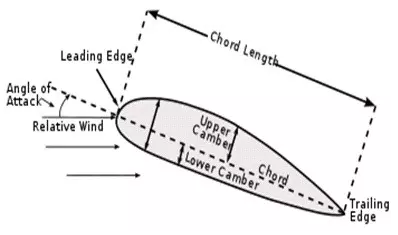The special shape of an airplane wing is called an airfoil. It is designed in a way to create less pressure above the wing.
An airfoil is a crucial component of an aircraft’s wing. It is the cross-sectional shape of the wing, designed to produce lift when air flows over it. The lift generated by an airfoil allows an aircraft to overcome gravity and stay aloft.
Introduction to Airfoil
An airfoil (in American English) or an aerofoil (in British English) is the shape of a wing or blade in cross-section. An Airfoil shaped body moved through a fluid produces an aerodynamic force. The component of this force perpendicular to the direction of motion is called lift. The component parallel to the direction of motion is called drag.
The lift of an airfoil is primarily the result of the angle of attack and shape (in particular its chamber). When either is positive, the resulting flow field about the airfoil has a higher average velocity on the upper surface than on the lower surface. This velocity difference is necessarily accompanied by a pressure difference (via Bernoulli’s principle) which in turn produces lift force. The lift force can also be related to the average top/bottom velocity difference without invoking the pressure by using the concept of circulation. Airfoil design is a major facet of aerodynamics. A fixed-wing aircraft’s wings, horizontal and vertical built with airfoil-shaped cross sections. Swimming and flying creatures also employ airfoils. Any object with an angle of attack in the air or moving fluid such as a flat plate will generate an aerodynamic force called lift.
Airfoils are more efficient lifting shapes able to generate more lift (up to a point) with less drag. this has to be the most primary and basic characteristic to be kept in mind while designing an airfoil for a wing span. Various airfoils serve different flight regimes. Asymmetric airfoils can generate lift at zero angles of attack while a symmetric airfoil may better suit frequent inverted flight as in an aerobatic airplane. The cross-section is not strictly circular however the radius of curvature is increased before the wing achieves maximum thickness to minimize the chance of boundary layer separation this elongates the wing and moves the point of maximum thickness back from the leading edge.

History of Airfoil Development
Could it be imagined how an aircraft gets into the air? It goes this way i.e. when the earliest serious work on the development of the airfoil sections began in the late 1800s. Although it was just known that flat plates would produce lift when set at an angle of incidence some suspected that the shapes with a curvature that more closely resembled the bird wings would produce more lift or do so, more efficiently. Sir H.F.Phiips patented a series of airfoil designs when he tested them in his earliest wind tunnel experiments.
The wide range of operating conditions and constraints generally makes the use of an existing “cat log” section, not the best. These days airfoils are designed for their intended application. This document tries to optimize the design of an airfoil with the help of an airfoil simulator.
Wrapping Up
In summary, airfoils are an essential component of an aircraft’s wing. They are designed to generate lift by creating a pressure difference between the upper and lower surfaces of the airfoil. The shape of an airfoil is determined by its camber and thickness, which affect its lift and drag characteristics. To maximize efficiency, airfoils are designed to have a high lift-to-drag ratio.
Read more about Mechanical Engineering technical topics.